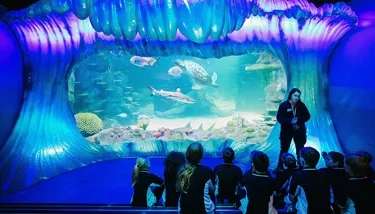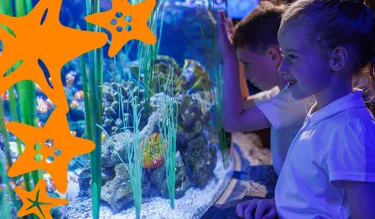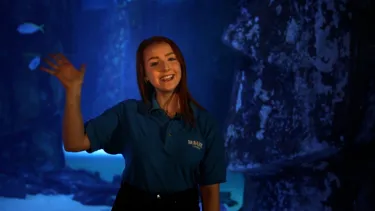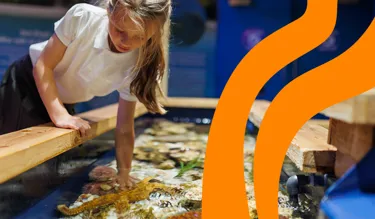Dive into Learning: How Aquarium Trips Inspire Knowledge, Empathy, and Love for the Ocean
- Tuesday 7th January 2025
- Laura Di Pasquale
- school trip, trip planning, teaching geography, science school trip

If you’ve ever seen a child stunned by the sight of a shark swimming above their head or the fact that jellyfish seem to float like ghosts, you’ll know that aquariums are breath-taking. For teachers, planning a school trip to an aquarium isn’t just about escaping the classroom (although, let’s be honest, that’s a perk), it’s about designing a day so full of awe and discovery that even your most easily distracted students forget to ask, “When’s lunch?”. In this article, we’ll dive into why aquariums are an unbeatable destination for educational visits, how to plan a trip that keeps things running swimmingly, and how to squeeze every drop of learning from the experience back in the classroom to deepen insights.
Why Visit an Aquarium? Turning Kids Into Ocean Advocates
Let’s face it: most children’s understanding of the ocean begins and ends with animated movies and TV shows. A trip to an aquarium changes that. Suddenly, they’re not just learning about marine life; they’re meeting it. From the elegant glide of a stingray’s fins to the hilariously sassy “what are you staring at?” attitude of a puffin, every creature in an aquarium has the ability to inspire kids to appreciate and care for the ocean. This matters because empathy is the first step towards action and creating our ocean advocates. Once students care about a creature, they start to care about its world. They’ll stop seeing the ocean as a big, salty swimming pool and start seeing it as a vital ecosystem that needs protecting. Be prepared for conversations about invasive species, microplastics, and why a turtle with a straw up its nose isn’t just a meme but a tragedy. Aquariums are also a treasure trove for geography, science lessons and stimulating questions: Why do octopuses have three hearts? Why jellyfish don’t have brains? What happens when a shark loses its teeth? (hint: they grow back, which is both fascinating and slightly terrifying). It’s like a science trip for schools, but with far more jaw-dropping moments and wide-eyed excitement.

Top Tips for Planning an Aquarium School Trip
So, you’re starting to be sold on the idea but how do you make sure your school trip doesn’t turn into a logistical shipwreck? Fear not, here are some top tips to keep your day afloat:
- Start with the basics:
A great trip begins with a good old fashioned risk assessment. SEA LIFE supports teachers in pre-visit planning by providing essential resources, including documents to assist in creating their own risk assessments. With every booking, they also offer 2 teacher planning tickets, allowing educators to familiarise themselves with the site in advance. This gives you time to figure out how not to lose any students when herding 30 through the gift shop. - Think curriculum, not chaos:
We know you’ve got the curriculum covered but did you know about The Conservation Classroom? It offers free teacher resources and lesson plans that will make you look like you’ve got your act together, even if you’re still figuring out how to print the permission slips. - Build the hype:
The aquarium is exciting, but you’ve got to sell it. In the weeks leading up, show ocean-themed videos, read marine books, or casually mention that you might see a shark (yes, sharks are the rockstars of the aquarium world—use this to your advantage). - Divide and conquer:
Put students into small groups with specific tasks, like finding out how sea otters open sea urchins or what sea cucumbers eat. Bonus: it gives the adults a break from answering “Can we touch the fish?” 437 times. - Pack smart:
Comfortable shoes, clipboards, and snacks are non-negotiable. For younger pupils, don’t forget sick bowls and baby wipes for the trip home after their ‘special’ lunch, and for older pupils, a reminder to pace themselves on snacks and souvenirs to avoid any mishaps!

Bringing the Aquarium Back to the Classroom
The aquarium might be over, but the learning is just beginning. Here’s how to keep the ocean vibes rolling once you’re back in the classroom:
- Talk it out:
Gather your students and ask the big questions: What did they love? What surprised them? Who thinks jellyfish are just plastic bags with better PR? These discussions consolidate learning and lead to deeper insights. - Get cross-curricular:
Use the trip to inspire projects across subjects. In science, dive into the fascinating world of marine ecosystems. In art, bring the underwater world to life with colorful creations. In literacy, challenge students to write imaginative stories from a turtle’s perspective - extra credit if they weave in a lesson about the importance of recycling. - Use online resources:
The Conservation Classroom has lots of free teaching ideas and lesson plans to keep the momentum going. It’s like a treasure chest of oceanic knowledge, minus the actual treasure (but still exciting). - Make a difference:
Challenge your students to turn learning into action. Set up a school-wide “No Plastic Week” or start a fundraising project for marine conservation. It’s the perfect way to teach them that even small actions can ripple into big changes - just like the ocean.

Why Aquariums Make the Perfect School Trip
Planning a geography or science school trip can be a lot of work, but watching a child’s eyes light up when they enter an aquarium is a joy to behold. It’s a journey into the ocean’s mysteries, a chance to inspire empathy, and an opportunity to show students how interconnected our world truly is. So, grab your sick bowls, risk assessment, top trip ideas, and maybe a bottle of aspirin. With a little preparation and a lot of enthusiasm, your aquarium visit just might be this year’s highlight. Who knows? It might even inspire the next ecologist, marine educator or blobfish-obsessed TikToker.
Now, go forth and make waves!
Related blogs

Ocean Conservation: Why Little Splashers Make Big Waves
Active citizenship might sound like something only MPs do, but for kids, it’s all about turning empathy into action. That’s where SEA LIFE’s Friends of the Sea initiative comes in. Think of it as a superhero training camp, minus the capes (although, who am I to stop you?)
Related blog posts
How a School Aquarium Trip Can Help Students Feel Calm
It’s no secret that the wellbeing of our children has taken a hit in recent years. From pandemic disruptions to the ever insisting presence of social media, young people face a barrage of pressures previous generations could never have imagined. However, what if there was a way to make learning about wellbeing fun, engaging, and memorable? Enter the humble aquarium trip!
Related blog posts
Creative, captivating and colourful: Ocean-inspired learning for KS1&2
The world’s oceans are full of hidden depths when it comes to cross-curricular learning for KS1&2 teachers. Here are five ideas for ocean-themed projects – and how to integrate them into the classroom.
Related blog posts
Oceans at COP30 + engaging activities to dive into
For teachers, COP30 is a good way to connect global policy to the classroom, showing students that protecting the ocean isn’t just about wildlife, it’s about climate, people, and our shared future.
Related blog posts